Take ownership of your files after access denied due to NTFS permissions
If you check the properties of the main storage device of your Windows computer, chances are you will see that it uses the NTFS file system ![]() . This is a very powerful and flexible system that Microsoft designed to keep your files organized between folders, keep track of which user can open which files, prevent malicious programs from messing up the system files and so on.
. This is a very powerful and flexible system that Microsoft designed to keep your files organized between folders, keep track of which user can open which files, prevent malicious programs from messing up the system files and so on.
When you are coping your files to an external hard drive formatted with the NTFS file system, you may not realize it but you are not only copying the contents of the files, you are also copying their attributes, including the security attributes. Depending on how this drive was formatted, the security attributes could be such that only you, the owner of these files, are allowed to open them, but other users should be restricted from doing that. Usually it all works well, until it does not. For example, if you've purchased a new laptop and attached the external drive to it hoping to get your files as you did many times in the past, but suddenly you are presented with a message saying "access denied":
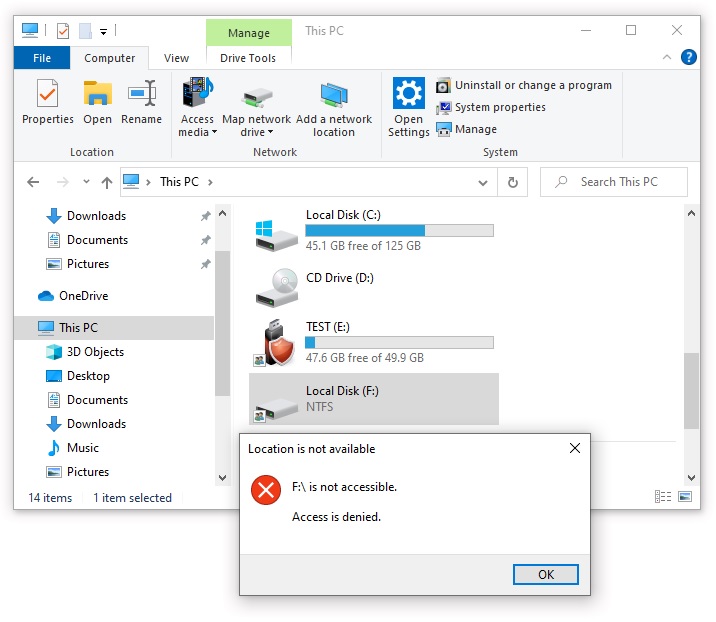
Before we continue, keep in mind that there could be several other reasons for the "access denied" message. For example, if you are accessing a network folder, shared from another computer, the access could be denied because the folder was shared in such a way as not to allow access to your user account. Or, the folder could be restricted by using an access control program such as our Folder Guard. If none of such conditions apply, then most probably the culprit is the NTFS permissions.
Also, a word of caution: changing the owner and security properties of files and folders is a powerful technique that, if used improperly, could lock you out of your files. Don't change the security settings of the system files and folders because you may lock yourself out of Windows itself and prevent your computer from starting properly. If you don't quite understand what's going on with the security of your files, ask someone more knowlegable for help, don't change something you don't understand because that can make things worse! Follow the instructions below at your own risk.
If you see the access denied message, the first thing to check is the security settings of the folder you are trying to open. In our example, it's the root folder of the drive F:. In File Explorer, open the This PC folder, right-click on the F: drive, choose Properties from the menu, and finally select the Security tab. Chances are you will see a screen similar to the following:
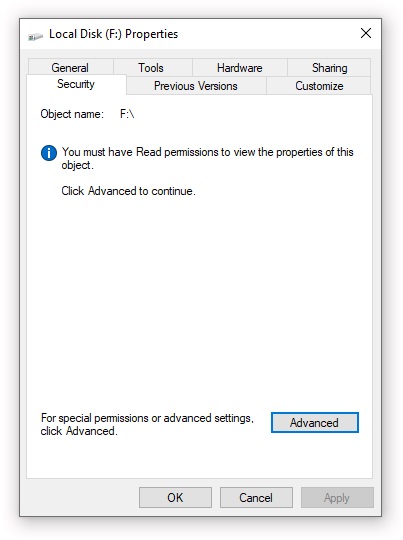
Let's follow the suggestion displayed and press the Advanced button:
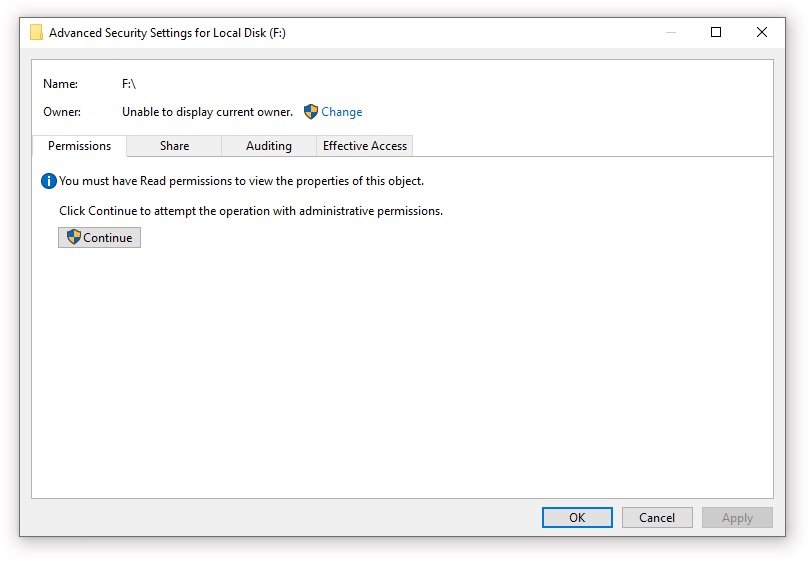
As you can see, Windows has restricted itself even from displaying the current owner of the folder! Fortunately, this is easy to fix. If you are the administrator of the computer, you can take ownership of the folder. Click on the Change text on the second line:
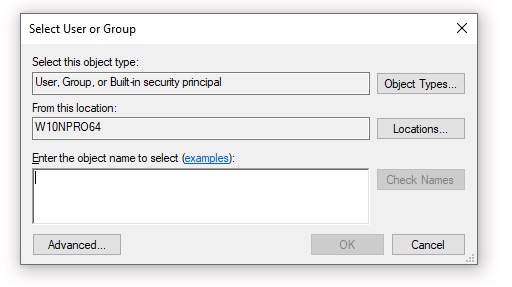
You can type your user name directly in the box or, if you are not sure, press Advanced and then the Find now button to display the list of users and groups, and select your user name in the list (which is User in our example, but in your case it will be probably something resembling your real name, like Joe Doe:)
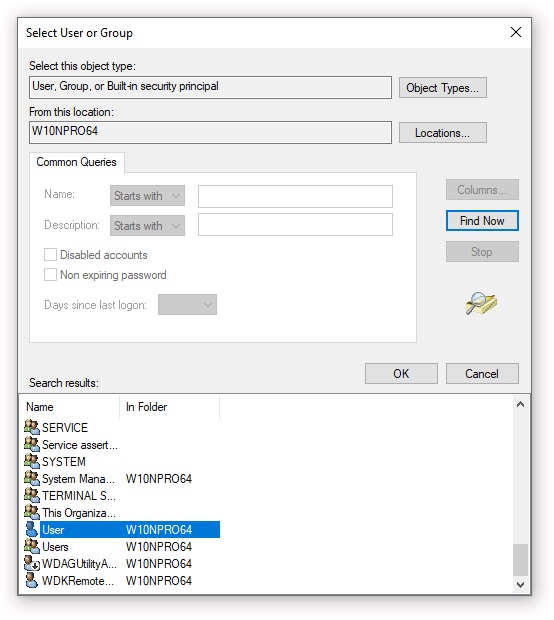
Press OK once or twice to return to the Advanced Security Settings screen and you should now see the user name you've just selected on the Owner line:
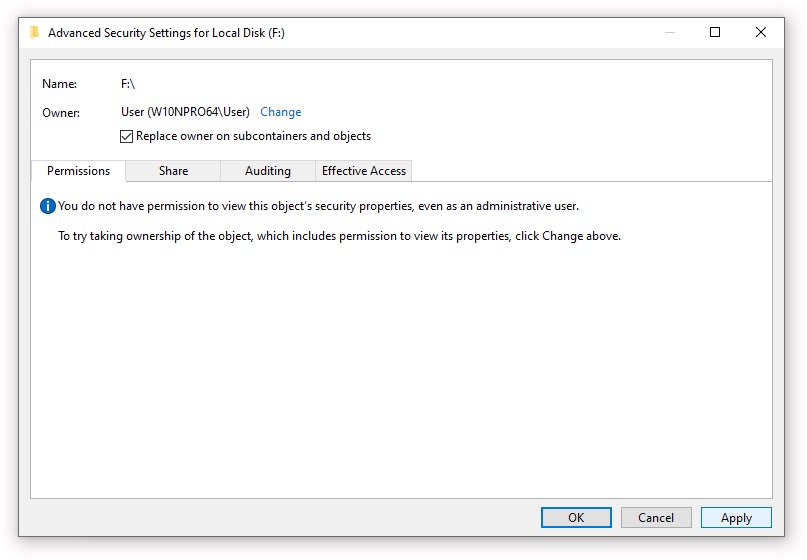
At this point you have selected your user account as the owner, but the change is not effective yet. To make it take effect, check the box that reads Replace owner on subcontainers and objects so that the new owner would be set not only on the root folder, but also on all files and folders under that root, and press Apply. You may see a prompt similar to the following asking you to confirm:
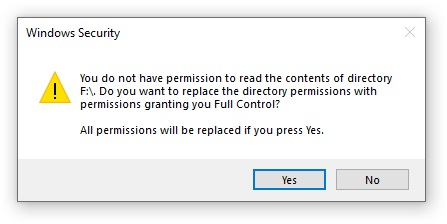
Press Yes and after a while you may see the following message:
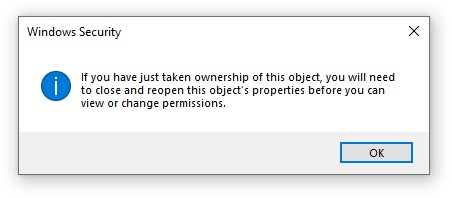
What it means is Windows is asking you to close the current screen displaying the properties of the folder and open it again, to make it display the changes. Let's do that, by closing the Advanced Security Settings and Properties screens, and then going back to the This PC folder, right-clicking on the drive F: icon, choosing Properties form the menu and selecting Security. You should see a more informative screen now:
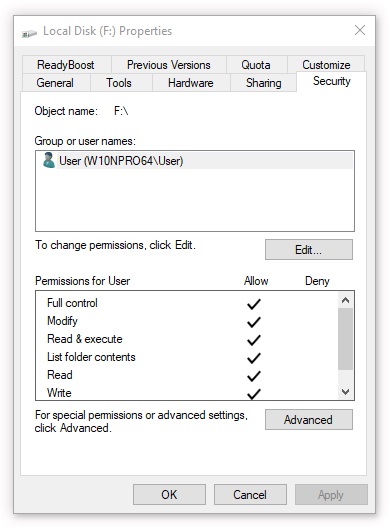
![]() Encrypt and password-protect files with Encryptability encryption software for Windows 11,10,8,7.
Encrypt and password-protect files with Encryptability encryption software for Windows 11,10,8,7.
User rating: ![]() 4.5 / 5
4.5 / 5
Purchase
or
download a free trial.
Read more...
You should be able to see your user name as the owner and also the list of permissions that your user account has over the root folder, with the check marks in the Allow column and none in the Deny column. To adjust these permissions, press the Edit button.
If the screen looks similar to the example above, you are on the right track. But you are not finished yet: you've only changed the permissions of the root folder, you still probably need to change the permissions of the files and subfolders to allow your user account to actually open the files. To do that, press the Advanced button and select the box at the bottom that reads Replace all child permission entries with inheritable permission entries from this object:
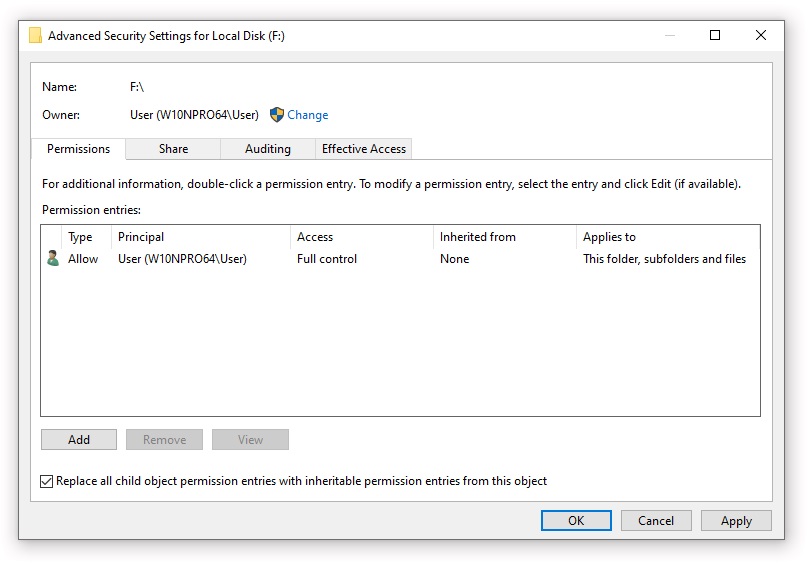
Windows may ask you to confirm this action, press Yes to allow it to proceed. If the drive has a lot of files and folders, it may take quite awhile to finish. When all is done, close the Properties window and try to browse the drive and open the files it contains. You should be able to have a full access now, without any "access denied" messages.
If you see a message about a corrupted Recycle Bin, like the following one:

![]() Password-protect and hide personal files and folders with Folder Guard for Windows 11,10,8,7.
Password-protect and hide personal files and folders with Folder Guard for Windows 11,10,8,7.
User rating: ![]() 4.7 / 5
4.7 / 5
Purchase
or
download a free trial.
Read more...
It's the result of changing the owner: Windows prevents you from peeking into the Recycle Bin created by the previous owner and retrieving the documents from it that used to belong to the previous owner. (It does not know it was you!) Reply Yes to empty the Recycle bin and it should become ready for use by you.
Happy computing!
If you want to link to this article, you can use this HTML code: <a href="https://www.winability.com/take-ownership-files-access-denied-ntfs-permissions/">Take ownership of your files after access denied due to NTFS permissions</a>
Read more
- How to disable Adobe's ability to scan all of your organization's documents for generative AI.
- [SOLVED] How to disable Taskbar Thumbnail Preview in Windows 11.
- How to restrict access to Microsoft Store app with Folder Guard.
- Tired of the Your password has expired and must be changed prompts? Here is how to stop them.
- How to move Pictures and other folders to Virtual Encrypted Disk.
- How to disable Fast Startup if you use encryption software.
- How to restore Videos, Pictures, and other folders in This PC in Windows 11.
- How to create a local user account in Windows 11 or Windows 10.
- How to enable or disable test signing mode in Windows.
- Email or SMS text messaging are NOT secure for two-factor authentication.
- Estimate how much you could save on electric bill with ActiveExit software.
- How to delete partition on Windows 11 or Windows 10.
- Forget VeraCrypt password? Here is how to recover it.
- Why do my desktop icons keep moving?
- How to create a private folder in Windows 11 and 10.
- How to restrict access to Windows Settings with Folder Guard.
 Suspending all contact with fascist Russia
Suspending all contact with fascist Russia- How to keep desktop icons from moving by running Icon Shepherd from command line.
- How to restrict access to Task Manager with Folder Guard.
- Take ownership of your files after access denied due to NTFS permissions.
- How to reprogram or disable CAPS LOCK key.
- Encryptability vs Folder Guard: which one to choose?
- Troubleshooting software removal problems using MSI files.
- Encryptability: Compare Personal and Business Licenses.
- How to add Group Policy and Local Security Policy to Windows 11 and 10 Home edition.
- [SOLVED] File is too large for the destination file system.
- Forget your WI-FI password? Find it in Windows 11 and 10 settings.
- What is FAT32 maximum file size limit?
- How to create a secret folder in Windows 11 and 10.
- How to easily password-protect Windows Linux folders with Folder Guard.
- Force DISKPART to delete EFI system partition in Windows 11 and 10.
- How to make Windows 11 and 10 recognize a cloned hard drive again.
- How to stop Windows 11 and 10 from using thumbnail preview icons for folders.
- How to hide pictures from the Photos app in Windows 11 and 10.
- How to save Windows Spotlight photos to your computer.
- How to move the OneDrive folder to an encrypted drive.
- Windows 10 fails to upgrade? Here is how to fix it.
- How to stop Microsoft Edge from opening PDF files.
- Preventing installations of specific programs with Folder Guard.
- Folder Guard licensing explained.
- Speed up the updates of the network folders.
- Make your Windows laptop work as a Wi-Fi access point.
- How to stop automatic Windows Update in Windows 10 and 11.
- [SOLVED] Windows cannot connect to the printer. Access is denied.
- Migrating encrypted data from TrueCrypt to USBCrypt.
- “The Microsoft account service is unavailable right now. Try again later.”
- Using DiffMerge as the external tool of AB Commander to compare plain text files.
- How to repair the icon cache and/or thumbnail cache in Windows 11 and 10.
- Transferring images between your PC and an Android device: Part 2.
- Transferring images between your PC and an Android device: Part 1.
- Case study: Using SoftDetective to suppress Corel Guide sign-in prompt.
- Using junction points to change the iTunes backup folder location.
- How to tell if my Windows computer is 32- or 64-bit?
- How do I stop Windows from rearranging my desktop icons?
- Organize your photo library with the Rename tool of AB Commander.
- Windows does not offer the NTFS format option? Here is how to bring it back.
- How to encrypt Firefox profile, bookmarks, and cookies.
- Restarting Windows 11, 10, and Windows 8 in the safe mode.
- Integrating AB Commander with Universal Viewer.
- How to delete a protected EFI system partition with Windows 11,10, 8, or 7.
- Using Folder Guard to protect from the social engineering attacks.
- How to erase Windows login password if you forget it.
- How to unhide a folder hidden with Folder Guard.
- How to repair Windows desktop icons with AB Commander.
- Slow network in Windows 7 Virtual PC? Speed it up!
- How to show drive letters first in AB Commander and Windows Explorer.
- What is my IP address?
- Why can’t I copy large files over 4GB to my USB flash drive or SD card?
- Test the strength of your password with USBCrypt.
- How to set up an external text editor for AB Commander.
- How to restrict Internet Explorer from downloading programs from the Internet.
- Personal vs business license for USBCrypt.
- Use Folder Guard to restrict access to Control Panel.
- Compare MySecretFolder and Folder Guard.
- Hide folders and make files invisible with Folder Guard.
- WINEXIT vs ActiveExit: automatically log off users from Windows.
- How to protect folder with password in Windows 11 and 10.
- How to restrict access and lock external drives with Folder Guard.
- How to password-protect Dropbox folder with USBCrypt.
- How to set up Folder Guard to stop downloading from the Internet.
- Is (Wipe the content) the same as (Secure Delete)?
- How to encrypt and protect the system C: drive with USBCrypt.
- Make it easier to return your lost encrypted drive.
- USBCrypt for users of Microsoft Office.
- How to start programs elevated from a batch file.
- How to make elevated programs recognize network drives.
- How to disable or enable hibernation.
- Using names and labels to organize USBCrypt drives.
- How to password-protect a USB flash drive.
- Always have a backup of your important files.
 Stand with Ukraine
Stand with Ukraine

